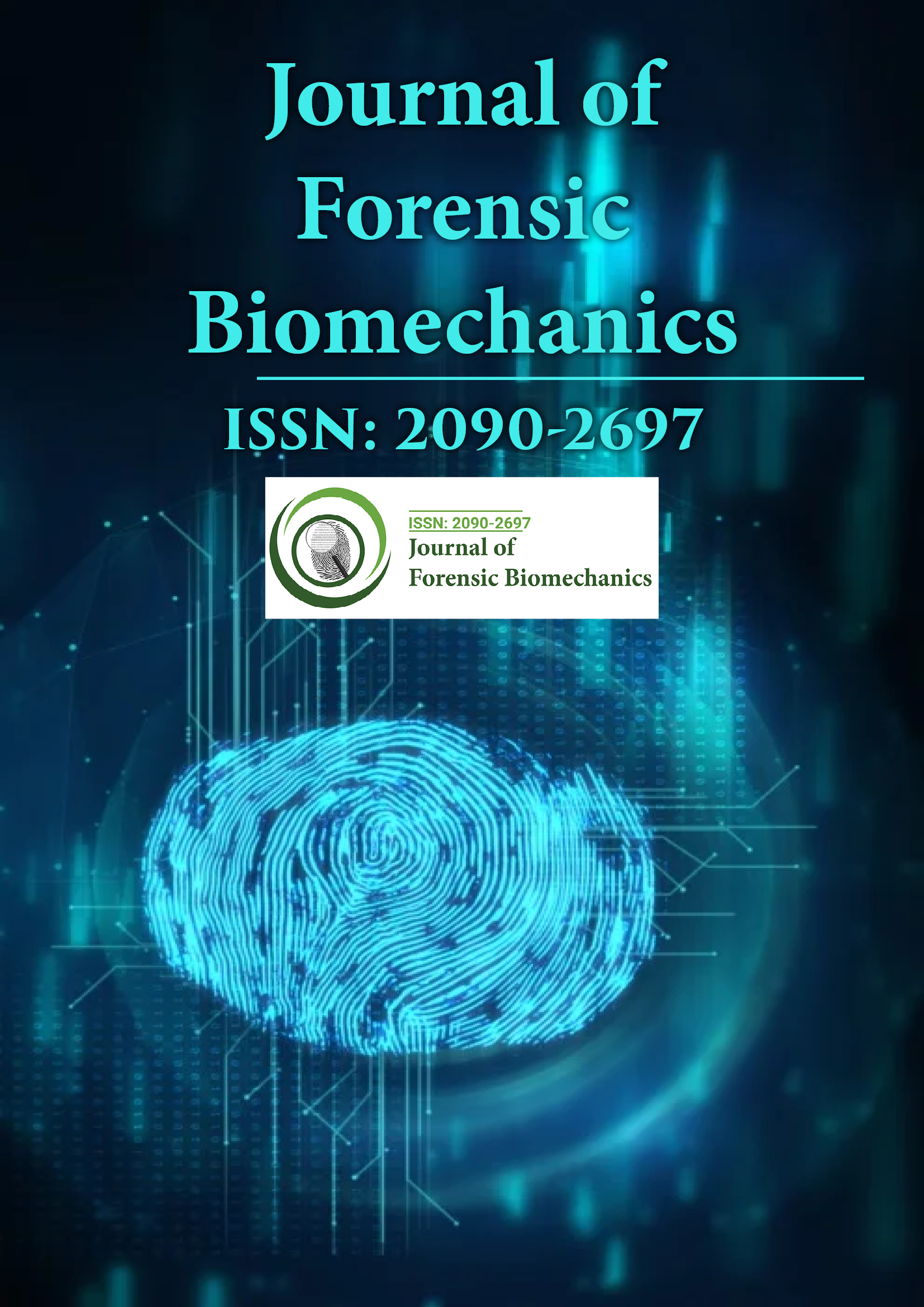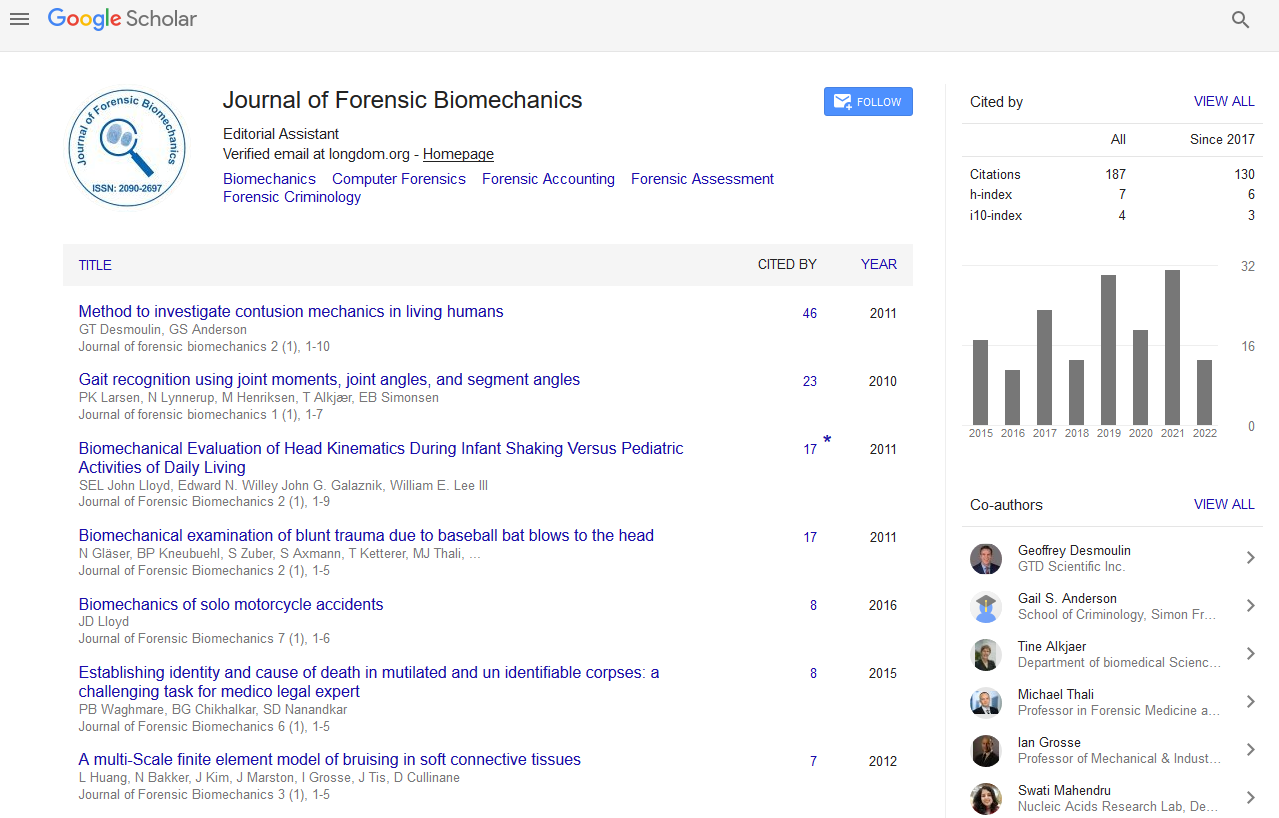Indexed In
- Genamics JournalSeek
- SafetyLit
- Ulrich's Periodicals Directory
- RefSeek
- Hamdard University
- EBSCO A-Z
- Geneva Foundation for Medical Education and Research
- Euro Pub
- Google Scholar
Useful Links
Share This Page
Journal Flyer

Open Access Journals
- Agri and Aquaculture
- Biochemistry
- Bioinformatics & Systems Biology
- Business & Management
- Chemistry
- Clinical Sciences
- Engineering
- Food & Nutrition
- General Science
- Genetics & Molecular Biology
- Immunology & Microbiology
- Medical Sciences
- Neuroscience & Psychology
- Nursing & Health Care
- Pharmaceutical Sciences
Commentary - (2022) Volume 13, Issue 2
General Classification of Trace Evidence: Overview
Received: 03-Mar-2022, Manuscript No. JFB-22-16065; Editor assigned: 04-Mar-2022, Pre QC No. JFB-22-16065(PQ); Reviewed: 18-Mar-2022, QC No. JFB-22-16065; Revised: 23-Mar-2022, Manuscript No. JFB-22-16065(R); Published: 30-Mar-2022, DOI: 10.35248/2090-2697.22.13.393
Description
Trace analysis is a field of forensic medicine that deals with small movements of substances that are invisible to the naked eye. Processing and analyzing traces requires attention and expertise. Trace evidence can provide a link between the victim and the suspect, the victim and the crime scene, or the suspect and the crime scene. The importance of trace evidence is often overlooked, but in the absence of definitive biological evidence, trace evidence may be the only source of information that can provide important research information. At crime scenes, small pieces of physical evidence such as hair, clothing and carpet fibers, and broken glass, often help tell what happened. These are called trace evidence and are transmitted when two objects come into contact with each other or when an action or movement emits small particles.
Scientists use various tools to find the physical and optical and chemical properties of trace events and compare samples, and search for sources or ordinary origins of each article. Most test methods require magnification and/or chemical analysis. It allows you to learn more about trace evidence, such as whether the object or body has been moved or if someone was attacked. The Trace Evidence Unit (TEU) identifies and compares a particular type of trace material that may be transferred between violent crimes committees. Trace events can contain various materials but the most frequently tested is hair, textile, glass, plant material, color chips, transfer, floor, fingerprints, low bombing, fireproof analysis and others.
Classification
The trace evidence department currently employs full-time analysts to review the type of evidence such as microscopic, impression, gunshot residue, hit-and-run investigation, mineralogy, anthropology.
Microscopic trace evidence
In addition to microscopic evidence, the Trace Evidence section also deals with physical evidence such as tire and shoe prints.
These are found in different types of materials such as paints, blood, dirt and dust. Information can be derived from the cast or print of these impressions and draw conclusions about the manufacturer and/or the type of object from which they are made. Other examples of impressions studied by the section may have been produced by cloth or hair.
Forensic hair testing distinguishes between human and animal hair and compares the characteristics of the microscope to distinguish between different individual hairs. Once the comparison is complete, the hair with the hair follicle marker can be sent to the nuclear DNA unit for analysis. Through hair comparison, type, color, body area, tip (cut, broken, crevice), removal method, illness, race, length, diameter, artificial treatment (staining/bleaching), time of course from last treatment, damage (crushed, broken, burned) can be identified.
Textile testing allows you to determine whether the fiber is natural or artificial. The fibers collected can be compared to fibers from known sources to determine if they match those from that source. It is possible to compare the collected fibers with other fibers to determine if they are from the same source but the source might be unknown.
Impressions analysis
Evidence of imprinting involves the interaction of two or more surfaces or objects, leaving a mark on the other, or removing part of the surface from one or both. Impressions are created by touching and retaining the properties of each objects. The impression analysis can be divided into four themes: shoes, tires, tool marks and others.
Gunshot residue analysis
The tracer uses a microscope to identify particles of propellant residue on clothing and other items. These residues are formed when the gun is fired and are mainly composed of burned and partially burned explosives, lead vapors, and other substances. Invisible residues can be generated using a variety of wet chemistry methods such as modified grease tests and sodium logistic tests. This information, and the type of pattern observed, can be used by investigators to determine the approximate distance between the victim and the shooter.
Glass analysis
They confirm the presence of glass by pushing the sample with a sharp object, determining its optical properties with a polarizing microscope, and attempting to dissolve the sample in water and observe glass characteristics such as color, transparency, surface properties, thickness, and fluorescence.
Fire debris analysis
Analysis of fire debris determines if there is an ignitable liquid residue added to the fire sample. Samples are submitted for analysis in an airtight container. Usually paint can be used for solid debris and a mason jar for liquid samples. These samples are tested for residual flammable liquids using two main methods: heated headspace and passive headspace.
Mineralogy
The FBI laboratory is one of the few crime laboratories that provide forensic geologic services. The mineralogy group provides both laboratory analysis and field assistance for cases involving geologic evidence. This includes both naturally occurring and manmade geologic materials. Materials examined typically include soil, glass, building materials, and gemstones. Additionally, through an agreement with the U.S. Geological Survey (USGS), the Mineralogy Group can now supplement forensic soil examinations with pollen analysis. Typical investigations include comparisons to establish a common origin, identification of unknown substances, and assessment of the geological origin or geographic location (provenance) of substances.
Anthropology
Forensic anthropology is an analysis of the remains of human skeleton in the context of forensic medicine. The Forensic Anthropology Program (FAP) provides both laboratory analysis and field support for cases involving skeletal debris.
Citation: Bryce A (2022) General Classification of Trace Evidence: Overview. J Forensic Biomech. 13:393.
Copyright: © 2022 Bryce A. This is an open-access article distributed under the terms of the Creative Commons Attribution License, which permits unrestricted use, distribution, and reproduction in any medium, provided the original author and source are credited.

